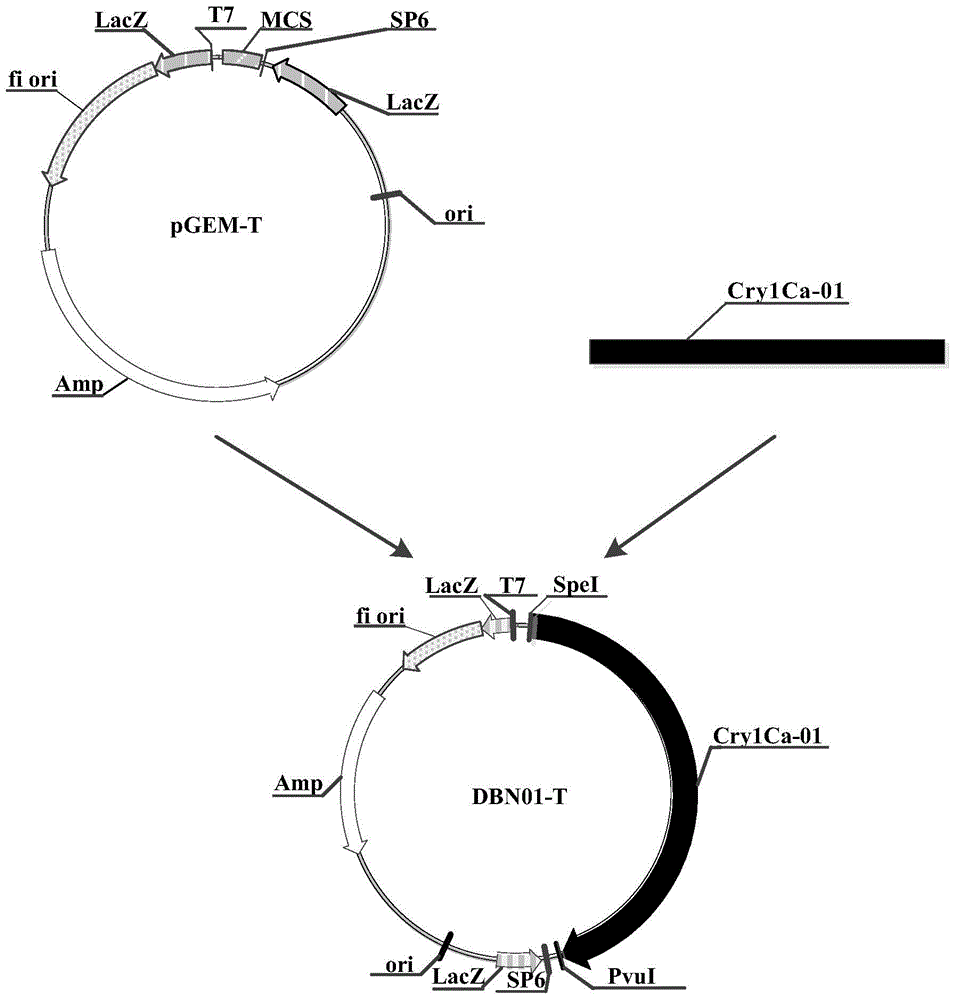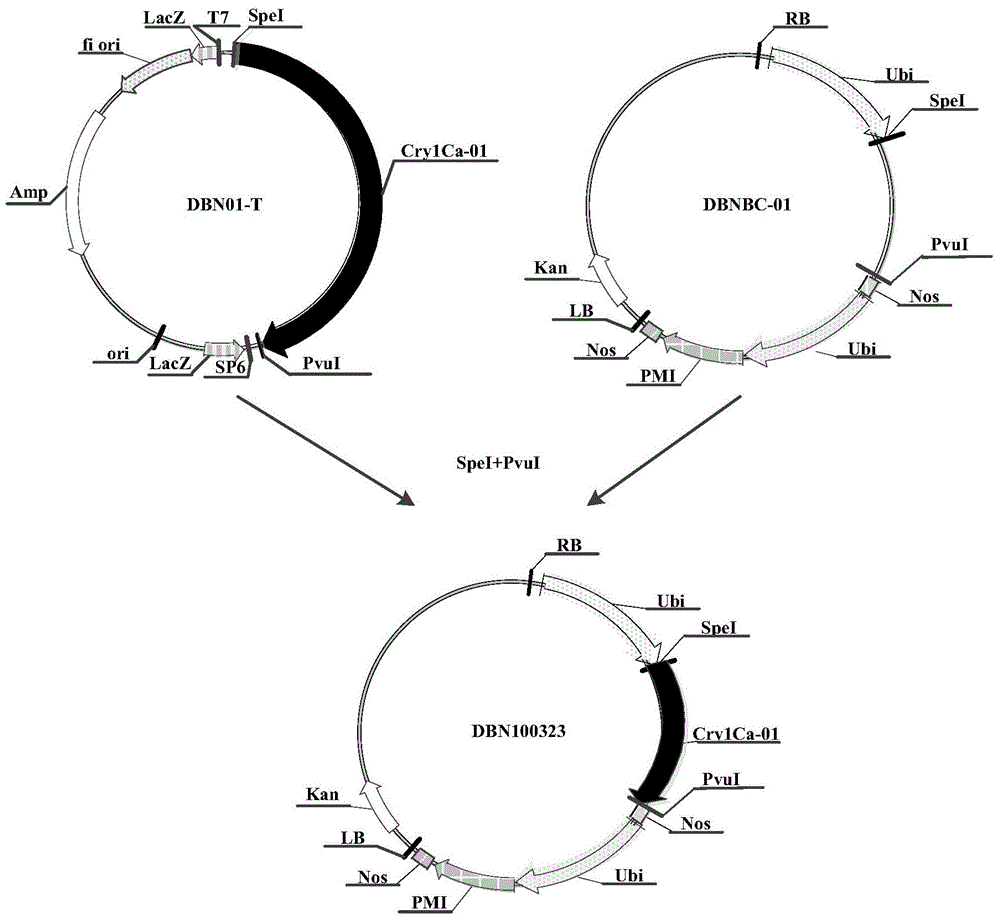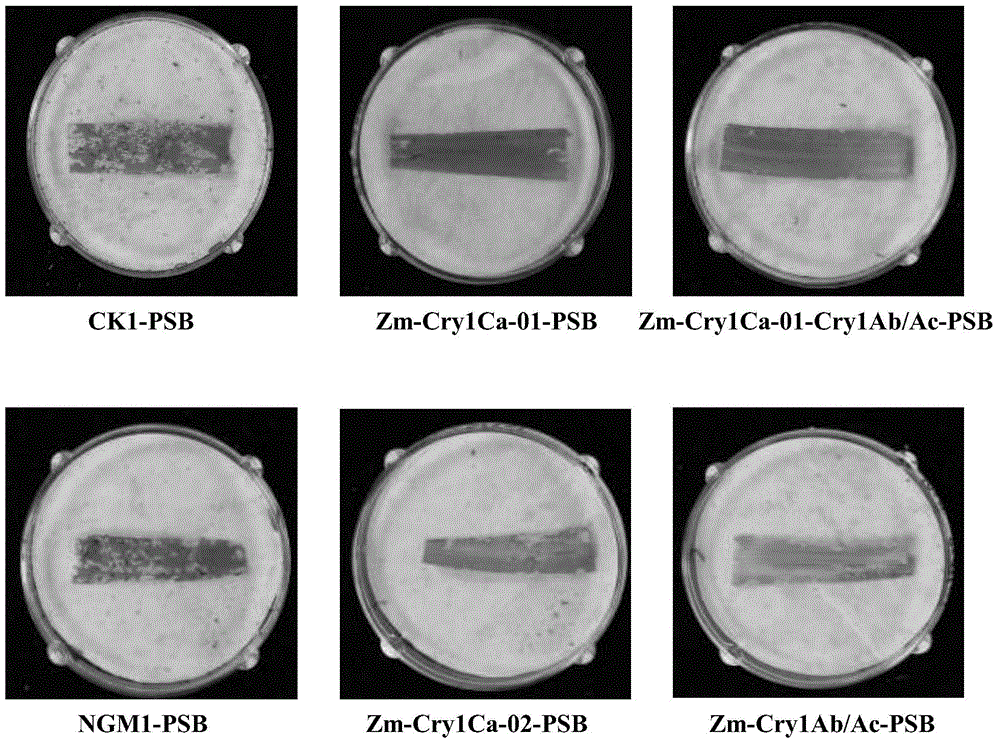Constructs and methods for controlling pests
A technology for constructs and pests, applied in botany equipment and methods, pesticides, and the use of vectors to introduce foreign genetic materials, etc., can solve problems such as increased production costs, environmental pollution, and low resistance
- Summary
- Abstract
- Description
- Claims
- Application Information
AI Technical Summary
Problems solved by technology
Method used
Image
Examples
no. 1 example
[0082] The first embodiment, the acquisition and synthesis of Cry1Ca gene and Cry1Ab / Ac gene
[0083] 1. Obtain the nucleotide sequences of Cry1Ca and Cry1Ab / Ac
[0084] The amino acid sequence (630 amino acids) of the Cry1Ca insecticidal protein is shown in SEQIDNO:1 in the sequence listing; the Cry1Ca-01 nucleotide sequence (1896) encoding the amino acid sequence (630 amino acids) corresponding to the Cry1Ca insecticidal protein nucleotides), as shown in SEQ ID NO: 3 in the sequence listing, and the Cry1Ca-02 nucleotide sequence (1896 nucleotides) is shown in SEQ ID NO: 4 in the sequence listing.
[0085] The amino acid sequence (609 amino acids) of the Cry1Ab / Ac insecticidal protein, as shown in SEQ ID NO: 2 in the sequence listing; the Cry1Ab / Ac nucleoside encoding the amino acid sequence (609 amino acids) corresponding to the Cry1Ab / Ac insecticidal protein acid sequence (1830 nucleotides), as shown in SEQ ID NO:5 in the sequence listing.
[0086] 2. Synthesize the above...
no. 2 example
[0088] The second embodiment, construction of recombinant expression vector and transformation of recombinant expression vector into Agrobacterium
[0089] 1. Construction of a recombinant cloning vector containing the Cry1Ca gene and the Cry1Ab / Ac gene
[0090] The synthesized Cry1Ca-01 nucleotide sequence was connected to the cloning vector pGEM-T (Promega, Madison, USA, CAT: A3600), and the operation steps were carried out according to the instructions of the pGEM-T vector produced by Promega Company to obtain the recombinant cloning vector DBN01-T , its construction process is as follows figure 1 Shown (wherein, Amp represents the ampicillin resistance gene; f1 represents the replication origin of phage f1; LacZ is the LacZ start codon; SP6 is the promoter of SP6 RNA polymerase; T7 is the promoter of T7 RNA polymerase; Cry1Ca-01 is the promoter of Cry1Ca -01 nucleotide sequence (SEQ ID NO: 3); MCS is a multiple cloning site).
[0091] Then, the recombinant cloning vector...
no. 3 example
[0103] The third embodiment, the acquisition and verification of corn plants transferred to Cry1Ca-01 and Cry1Ab / Ac genes
[0104] 1. Obtain corn plants transferred to Cry1Ca-01 and Cry1Ab / Ac genes
[0105]According to the commonly used Agrobacterium infection method, the immature embryos of the aseptically cultured maize variety Zong 31 (Z31) were co-cultured with the Agrobacterium described in 3 in the second example, so that the T-DNA in recombinant expression vectors DBN100323, DBN100060, DBN100056 and DBN100062 (including the promoter sequence of corn Ubiquitin gene, Cry1Ca-01 nucleotide sequence, Cry1Ca-02 nucleotide sequence, Cry1Ab / Ac nucleotide sequence, PMI gene and Nos terminator sequence) were transferred into the maize genome, and the maize plants transferred to the Cry1Ca-01 nucleotide sequence, the maize plants transferred to the Cry1Ca-02 nucleotide sequence, and the Cry1Ab / Ac nucleoside The maize plant of the acid sequence and the maize plant of the Cry1Ca-01...
PUM
 Login to View More
Login to View More Abstract
Description
Claims
Application Information
 Login to View More
Login to View More - R&D
- Intellectual Property
- Life Sciences
- Materials
- Tech Scout
- Unparalleled Data Quality
- Higher Quality Content
- 60% Fewer Hallucinations
Browse by: Latest US Patents, China's latest patents, Technical Efficacy Thesaurus, Application Domain, Technology Topic, Popular Technical Reports.
© 2025 PatSnap. All rights reserved.Legal|Privacy policy|Modern Slavery Act Transparency Statement|Sitemap|About US| Contact US: help@patsnap.com



